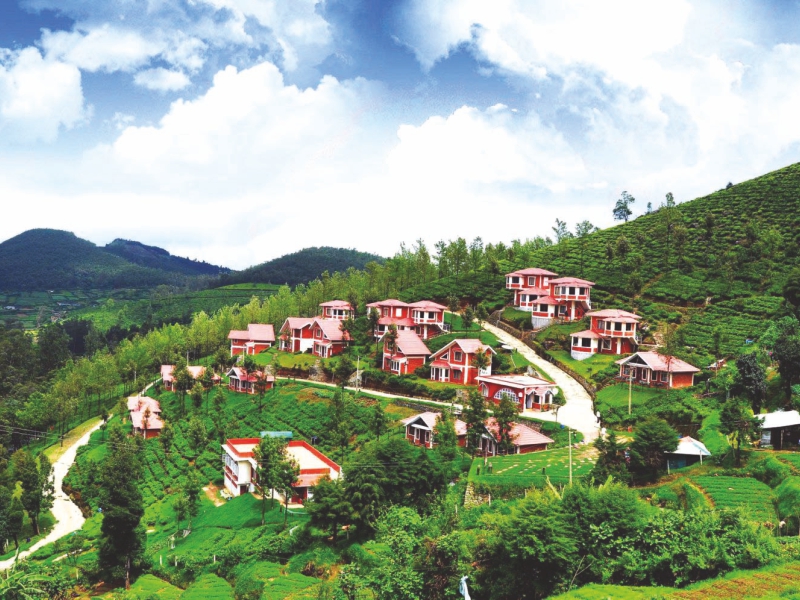
Notwithstanding the ravages of the past half century the Blue Mountains continue to exert a strong allure and the hill stations of this southern state attract large crowds through the year
Recently a group of trekkers set off down the The Finicio Trail in the Nilgiris aka, the Blue Mountains. The three day trek followed a rough track, from Mannarkand in Kerala to Melur village in the Nilgiris — the same path that Jacome Finicio, a Jesuit priest, took in 1603 in search of the lost tribes of Israel. Finicio’s report was the first ever-recorded document of the idyllic environs and hospitable tribes of the Nilgiris.
Now, 418 years later, a lot has changed. Efforts to make the hills profitable during the past 30 years in particular have been at the expense of the pristine environment of the Blue Mountains. Water drained from the Nilgiris now supports 50 percent of Tamil Nadu’s hydroelectric power and irrigates 2,000 hectares of agricultural land. The development of tea, coffee and tourism industries in the region has turned its ecosystem topsy-turvy. The Finicio trail is one way of marketing the hills through ecotourism and help them regain their past splendour. The government of Tamil Nadu is also making belated efforts to preserve the environment of its premier hill station Ooty, by restricting further construction in this region, according to a senior government official of the Tamil Nadu Tourism Development Corporation. It is also keenly promoting other hill stations in the state through publicity campaigns and advertisements in the media.
Notwithstanding the environmental ravages of the past 60 years, the Blue Mountains continue to exert a strong allure and Ooty still retains much of its stately, natural charm which has earned it the title of Queen of Hill Stations. Similarly, other hill stations of Tamil Nadu — Kodaikanal, Yercaud and Elagiri Hills — continue to attract large crowds through the year, especially in the blistering summer months, when the mercury in the plains can shoot upto 40oC and higher. To those who can afford to get away, these hill stations offer a cool bracing climate, natural beauty, fresh air, picturesque mountain views and refreshing solitude.
It was in these hills that the British, who ruled the southern peninsula (then known as the Madras Presidency) from the mid-18th century, first discovered the coolant charms of the ‘little England’ hill resorts of Tamil Nadu to which they could make a quick getaway come summer. A massive effort in terms of planning and engineering feats of mind-boggling complexity was undertaken to make the hill stations accessible to the public. Today these resorts which are perhaps the most enduring and appreciated legacies of the British raj, attract ever growing numbers of middle class tourists from across the country to engage in adventure activities like trekking, river rafting and hang gliding and to enjoy the annual summer festivals and cultural shows that are a common feature of every hill station.
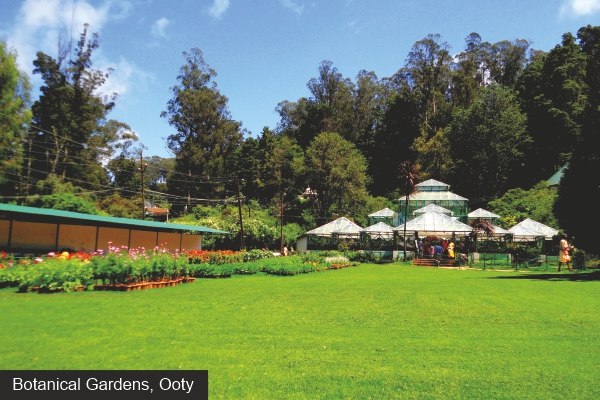 Udhagamandalam (Ooty)
Udhagamandalam (Ooty)
Nestling in the heart of the Blue Mountains, which derive their name from the blue haze which envelopes them, is Udhagamandalam (Ooty), located at a height of 7,000 ft above mean sea level. Nature is at its best in this sylvan paradise replete with gardens, rolling hills, fragrant pine, eucalyptus and conifer trees, and tea plantations and estates. The refreshing coolness of the hills (temperature here rarely rises above 250 C in summer with a minimum of 100 ) makes it an ideal getaway for rest and recreation, especially when the mercury shoots up in summer. This popular tourist destination saw a footfall of 1 million in April and May 2019, 53,000 more than the previous year.
The history of Ooty dates back to the 19th century when the British first discovered this ‘home away from home’ in the early 1800s. However, the earliest inhabitants of this salubrious terrain were the Toda tribals. The British built the first railway line in the area, developed it, and converted Ooty into the summer capital of the Madras Presidency. In 1818, Wish and Kindersley, assistants of the collector of Coimbatore, John Sullivan, visited this spot and submitted a report recommending the development of Udhagamandalam. It began with the construction of the Stone House or ‘Kai Bangla’ by John Sullivan, which is now the chamber of the principal of the Government Arts College. Following the construction of Stone House, several quaint English cottages and bungalows of top government officials were built. Even today, vestiges of the British Raj linger in the Nilgiris library with its rare and valuable collection of books and in St Stephen’s Church. built in 1829.
Among the major tourist attractions Ooty offers, are the exotic Botanical Gardens sprawling over 50 acres, and maintained by the horticulture department of the government of Tamil Nadu. The Annual Summer Festival held here in May is a big draw for tourists with the Flower Show being the highlight of the event.
Another must-see is the magnificent Doddabetta Peak (9,180 ft), the highest in South India. Rising at the junction of the eastern and western ghats, it offers breathtaking views of the hills. Equally delightful are the vistas from Elk Hill, Green Valley and Snowden Peak. An artificial lake with boating facilities, a mini garden for children with an amusement park, a rose garden spread over ten acres with nearly 2,000 varieties of roses, the government museum, deer park, Wenlock Downs and sprawling tea plantations, are the other attractions of this popular — perhaps too popular — hill resort. Ooty also offers adventurous trek routes, besides leisure pursuits like fishing, golf and hang-gliding. The Annual Tea and Tourism Festival held in January is particularly recommended.
Ooty is 105 km from Coimbatore, which is the nearest airport and is well connected by rail and road to major cities of the south. The peak season is April-June and September-October.
Accommodation. High-end: Tiger Hill Homestay (Rs.11,440 per night), Welcomheritage Ferrnhills Royale Palace (Rs.11,750), Hotel Fortune Resort Sullivan Court (Rs.6,045). Mid-range: KSTDC Hotel Mayura Sudarshan Ooty (Rs.2,958), Leopard Park Wilderness Resort (Rs.4,700), Hotel Meadows Residency (Rs.3,382). Budget: Modern Villa (Rs.908), Irinjalakuda home stay (Rs.1,786), Brevery Vila (Rs.1,995).
Restaurants. Quality Indian and continental fare is readily available in Ooty, but restaurants tend to be heavily booked in summer and long queues are a common sight. Among the better eateries are Blue Hills, Chandan Vihar, Tamizhagam, Earl’s Cliff, Tandoor Mahal, Pankaj Bhojanalaya, Ooty Coffee House, Raghuram and Chinkos Chinese Restaurant.
Excursions. For those in search of scenic picnic spots and adventure there are day-time excursions to Wellington (16 km), Kotagiri (29 km), Kalhatti Water Falls (13 km), Glenmorgan (17 km), and Ketti Valley View. The contiguous resort town of Conoor (17 km) situated at an altitude of 6,000 ft merits a visit for its equable climate and a well-maintained Botanical Garden known as Sim’s Park. Conoor’s other attractions are Dolphin’s Nose, Lambs Rock, Lady Canning’s Seat, and St. Catherine Falls.
Further afield is the Mudumalai wildlife sanctuary (65 km) with varied animal and bird life; Theppakadu elephant camp with rich fauna; Mukurthi Peak (40 km) and Mukurthi National Park, located on the south eastern corner of the Nilgiris and the picturesque Silent Valley on the western side of these ranges; the Pykara dam (21 km), Pykara Falls and reservoir in the vicinity of charming Toda settlements and wildlife habitats are also a popular draw with tourists.
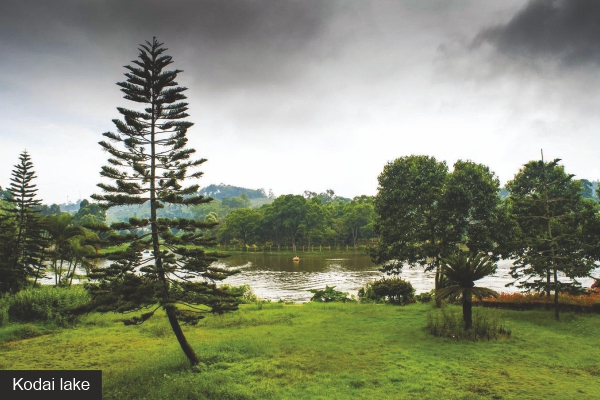 Kodaikanal
Kodaikanal
Thickly wooded slopes, tumultuous waterfalls and precipitous rocky outcrops characterise this serene hill resort located 120 km from Madurai which rises to an altitude of 2,133 metres (6,932 ft) on the southern tip of the upper Palani hills in the Western Ghats. The bracing climate, which does not vary much between summer and winter and salubrious surroundings are this charming hill station’s unique selling proposition. The pride of Kodai is the unique Kurinji flower which blossoms once in 12 years turning its numerous hill slopes into a blaze of purple. This hill town spread over 21.45 sq km is also renowned for educational institutions of international repute.
Kodaikanal (pop. 36,501) is centred around the man-made, star-shaped Kodai lake spread over 60 acres. The lake was engineered in 1863 by Sir Vere Hendry Levinge, then collector of Madurai. In 1890 a boat club was promoted. In 1910 a new boat house was constructed but it was only in 1932 that boating services were extended to the public. A short walk from the lake brings you to Bryant Park, noted for its flowers — hybrids and grafts. A glass house within the park has numerous exotic varieties of flowers on display. The Annual Flower Show is conducted here in May as part of the summer festival. About 5 km from the lake is the Shenbaganur Museum devoted to archaeological remains and flora and fauna of the hills. The museum houses one of the best orchidoriums in the country with more than 300 species of orchids on display. Among the other attractions of Kodaikanal are Coaker’s Walk, a vantage point for an unending view of the plains; Silver Cascade waterfall (8 km) and the scenic Berijam lake (21 km) which are excellent picnic spots. The 2,343-metre (7,615 ft) Solar Physical Observatory, 32 km from the lake is the top most point for observing the stars and planets of the galaxy and its two telescopes provide a wonderful view of the valley and its towns. The Kurinji Andavar temple, situated 3 km from the lake and dedicated to Lord Muruga, is a famous place of worship. By way of entertainment and leisure activities, Kodaikanal provides angling, boating, trekking and golf facilities.
Kodaikanal is easily accessible from all major towns and cities. The nearest airports are Madurai (121 km) and Coimbatore (135 km). The nearest railway station is at Kodai Road (80 km) and Palani.
Accommodation. High-end: The Tamara Kodai (Rs.9,400 per night), The Carlton (Rs.10,105). Mid-range: Hotel Kodai International (Rs.3,610), Sterling Kodai Valley Resort (Rs.3,517), Great Trails Kodaikanal by GRT Hotels (Rs.4,230). Budget: The Hamse (Rs.2,820), Hilltop Towers (Rs.1,947), Hotel Jem Valley (Rs,2,218), Hotel Spring Valley (Rs,764).
Excursions. Visitors to the Dolmen circle situated 18 km from the lake can see the pre-historic remains and artefacts of the region. A major attraction is Thalaiyar Falls also known as Rat Tail falls, one of the highest waterfalls in the world. The Kukkal caves (40 km), a campsite in the wild, show traces of the earliest inhabitants of the region, the leaf[1]clothed Paliyans. A visit to Kodaikanal is incomplete without a visit to the famed pilgrim centre of Palani (64 km) with its Dandayudhapani temple dedicated to Lord Subramanya atop a 140 mt hill.
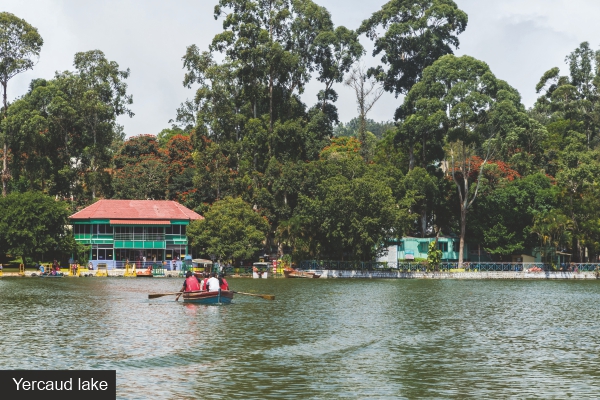 Yercaud
Yercaud
Known as the Jewel of the South, Yercaud, situated at an altitude of 4,875 ft above mean sea level on the Shervaroyan hills (Shevaroy range) in Salem district, is a quiet, restful hill resort (pop. 41,869). It derives its name from the calm yeti (lake) once surrounded by kadu (forests). The salubrious climate of Yercaud where the temperature never rises above 300 C or falls below 130 C draws tourists through the year.
Though Yercaud plays handmaiden to queen Ooty and princess Kodaikanal and does not offer much to sightseers and thrill seekers, it is scenically no less alluring and offers the advantage of being the most affordable hill station in India. Dotted with coffee plantations and orange groves, Yercaud provides excellent opportunities for trekking, boating and nature walks.
A quiet and secluded hill station, it was first discovered by the British in the early 19th century. History gives accounts of coffee plantations being introduced by a British officer in the second decade of the 19th century. Though the first house in Yercaud was built in 1840, proper roads were laid only in the early 20th century. The cool and pleasant climate attracted Christian missionaries who established the Sacred Heart Convent for Girls and the famous Montfort School for Boys, named after the founder St. Louis Merie Grigmon de Montford. A large number of students came from foreign countries to study in these institutions. In 1945, the Brothers of Don Bosco established a retreat, an institution that serves as a Novitiate House where students of the religious order stay and study to this day.
Visitors have to pass through the textile town of Salem, before entering this quaint country resort whose chief attraction is the Yercaud lake, surrounded by gardens and woods and ideal for boating. There is the well-maintained Anna Park nearby and the view from Lady’s Seat, which overlooks the winding ghat road is spectacular, especially at night.
Other spots worth visiting are Pagoda Point; the 90 ft Killiyur Falls, and Bear’s Cave. The Shervaroyan-Kaveri Amman temple inside a dark cave on the tallest peak (5,342 ft) in the Shervaroyan hills, stages an annual festival in May which attracts thousands of pilgrims.
Accommodation. High-end: Great Trails Yercaud by GRT Hotels (Rs. 8,930 per night), Escape – La Four Season (Rs.8,876), Myst-Yellow Lakes Resport and Spa (Rs.11,056) Mid-range: TGI Star Holidays (Rs.2,315), Grand Palace Hotel and Spa (Rs.3,008), WOW Bison Resort (Rs.3,214) Budget: Hotel KC (Rs.1,038), Premier Inn (Rs.1,880).
Excursions. Yercaud offers several religious and eco-tourism excursion options. Salem district (35 km) is rich in mineral wealth and famous for mangoes, stainless steel and handlooms. Around 25 km from Salem is Tharamangalam town known for its Sri Kailasnatha temple. Namakkal (52 km from Salem), at the foot of a small hillock, also merits a visit for its two rock cut cave temples and 18 ft tall monolithic Hanuman idol. Thiruchengodu (45 km from Salem) is one of the seven Sivasthanams in Kongunadu and is famous for the Arthanareeswarar temple located on a hillock. The Sangameswarar temple in Bhavani (63 km from Salem) is another important pilgrim centre in South India. Another must-see is the Mettur dam (53 km from Salem), one of the oldest in India and constructed in a gorge where the river Cauvery enters the plains. The Kolli Hills (110 km) situated on the Eastern Ghats at an altitude of 1,190 metres (3,986 ft) in Namakkal district, attract tourists for medicinal herbs and plants, a scenic waterfall and temple.
Another unexploited tourist wonder is the Hogenakal Waterfall (113 km from Salem) on the river Cauvery. A sacred bathing and picnic spot, Hogenakkal is famed for the curative power of its waters.
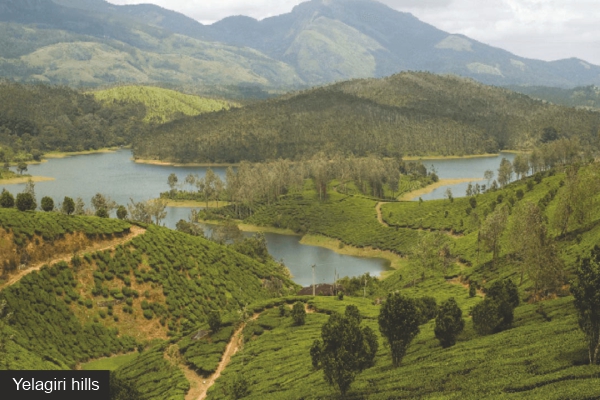 Elagiri Hills
Elagiri Hills
Rising 3,500 feet above sea level amid four mountains, this is a lesser-known hill station with a pleasant climate and natural beauty. The nearest railway junction is Jolarpet, connected by a 14 km Ghat Road starting from Ponneri up to Elagiri. The road has 14 hairpin bends that offer a panoramic view of the plains, mountain slopes and green forests.
Though Elagiri does not have much to offer by way of sightseeing or entertainment, tourists come here for its peaceful environment and for trekking and rock climbing holidays. The Punganur Lake here is an enchanting artificial water body with boating facilities. A fountain has been installed in its centre which spouts water to a height of 15ft and creates an ethereal glow around the lake when illuminated at night. The six acre children’s park adjacent to the lake, a mini zoo, the Velavan temple for Lord Murugan atop a hillock, and Telescope House are some other spots worth visiting.
The Government Fruit Farm or Botanical Gardens at Athnavur and Nilavur, the two towns of Elagiri, showcase exotic fruit bearing trees and plants. A trip to the government herbal farm adjacent to the lake where herbs and shrubs are cultivated to produce ayurvedic and siddha medicines is also an educational experience. Jalagamparai falls situated 15 km from Tiruppathur, an hour’s trek from the hills is a fine picnic spot. Adjacent to the falls is a Murugan temple located in a structure constructed in the shape of a Shivalingam, which attracts tourists through the year.
Elagiri is endowed with several convenient trekking routes through dense reserve forests leading to cascading waterfalls, peak points and valley views for the adventurous. The nearest airport is Chennai (220 km) and Bangalore (185 km). The nearest railhead is Jolarpet and buses also ply from Jolarpet, Vellore and Tiruppathur.
Accommodation. There are a few mid-range and budget hotels, which offer food and lodging. Some of these are Great Days Resort (Rs.9,400 per night), Yelagiri Villa (Rs.4,928 per night for the entire villa), Sarvakaya (Rs. 4,240), Sri Sai Vethathiri Holiday Cottage Yelagiri (Rs.2,700).
Also Read:
Hampi – testimony to a golden age


























